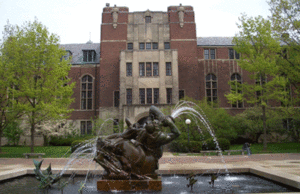WaterComputerized irrigation system saves money
The University of Michigan is using a computerized irrigation system for its campus landscaping; the system uses information from a campus weather station that monitors wind speed, rain, temperature, and humidity to adjust irrigation schedules; the system allowed the school to reduce the amount of water used on irrigation by 22 million gallons of water on landscape irrigation each year — or 68 percent relative to the amount of water used before the system was installed — saving an estimated $141,000 a year

UM campus landscaping watered by computer // Source: umich.edu
Installation of a water-conserving irrigation system has helped the University of Michigan reduce the amount of water used on irrigation by 68 percent, saving an estimated $141,000 a year. The university says that through this commitment to sustainability and the use of smart technology, the university is not only saving money but also is working to help the planet.
Since 2006, the university has operated a computerized irrigation system, called Maxicom, across parts of the North and Central campuses. The system uses information from a campus weather station that monitors wind speed, rain, temperature, and humidity to adjust irrigation schedules.
The result is a savings to the university of approximately twenty-two million gallons of water on landscape irrigation each year, which is enough water to fill thirty-three Olympic swimming pools or sustain an average household for 172 years. At current water rates, this results in annual savings of $141,000.
“We can track where every gallon of water is going within our irrigation system,” says John Lawter, associate director for plant buildings and grounds services. “This system allows us to efficiently manage our resources while keeping the campus green.”
The total cost of the project was $350,000. Partial funding — $232,700 — was provided by U-M’s Energy Star Program modeled after the Environmental Protection Agency conservation program to encourage the production and use of energy-efficient equipment. Since being fully installed, the system has helped the university avoid $564,000 in water costs.
The project is part of the university’s overall efforts to continually control and reduce costs. In fiscal year 2010, the university reduced its water usage by 3 percent — to its lowest level used in the past seven years — through various conservation methods and its comprehensive storm-water management program.
Each day, the campus weather station — located on North Campus — communicates with the on-site irrigation controllers through telephone and radio signals. Weather data, such as rainfall totals, is shared with a central computer, which then calculates how much, if any, supplemental water campus plants and lawns need. The system then automatically updates the irrigation schedule. Any changes in the program can be done at the central computer or remotely by phone.
Individual timers that require a physical trip to the site for adjustments typically control irrigation systems.
With the Maxicom system, the weather station enables same-day adjustments of schedules in all of the system controllers, something that is not possible through manual operations. The system also is capable of detecting leaks and breaks in irrigation equipment and automatically will shut off water to any damaged area.
The Maxicom system is installed in 95 percent of general fund locations but has expansion capability to add auxiliary units.
Other water conservation measures on campus include the installation of low-flow toilets, faucets, showers, and urinals in buildings across campus. The university also is installing water refill stations across campus, which provides the campus community the choice of using refillable water bottles.
